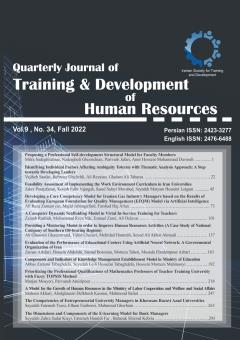-
-
List of Articles
-
Open Access Article
1 - Providing a structural model of professional self-development for faculty members
Mitra Sadeghi Tabar nadergholi ghorchian parivash jafari Amir Hossein Mohammad Davoudi -
Open Access Article
2 - Identifying the individual factors affecting the competency of leaders to tolerate ambiguity with using the approach of Theme analysis; A step towards developing leaders
Vajiheh Saadat Behrooz Ghlichlee Ali Rezaee Gholamali Tabarsa -
Open Access Article
3 - investigating the feasibility of establishing the workplace curriculum in Iranian universities
zahra pourjafarian koroush fathi vajargah Saeed Safaei Movahed maryam Hoseini Lorgani -
Open Access Article
4 - Designing a core competency model for Iranian gas industry managers based on the results of EFQM by artificial intelligence method
Ali reza Zamanian Majid Jahangirfard Farshad Haj alian -
Open Access Article
5 - Designing and Validating Dynamic Computer-Based Scaffolding Model in Virtual In-Service Teacher Training
Zeynab Rashidi mohammadreza nili Esmaeil Zaraii Ali Delavar -
Open Access Article
6 - Introducing Mentoring Model By Improving Human Resources Practices Approach, (Case Study: National Iranian South Oilfields Company)
Ali Ghasemi Ghasemvand Vahid Chenari Mehrdad Hamrahi aliakbar ahmadi -
Open Access Article
7 - Performance evaluation model of educational centers using artificial neural network: One of the government organizations in the country
zaman azhdari Hosein Abdollahi samad Borzoian morteza Taheri mostafa Ebrahimpour Azbari -
Open Access Article
8 - Components and indicators of the model of establishing knowledge management in the organization
َAbbas Zamaani Tabaghdhi Leyla Hoseini Tabahgdehi Hossein momenimahmouei -
Open Access Article
9 - Prioritization of Professional Competencies of Mathematics lecturers of Farhangian University through topsis fuzzy
marjan moayeri parvaneh amiripour -
Open Access Article
10 - Provide a model for the growth of human resources in the Ministry of Labor Cooperation and Welfare and Social Affairs
mohsen akbari Abolghasem Delkhosh Kasmaee Mahmood safari -
Open Access Article
11 - Identifying and Explaining the Competencies of the Managers of Entrepreneurial Universities with an Organizational Learning Approach (Case Study: Azad Universities of Khorasan Razavi)
Fatemeh Toosi Elham Fariborzi Mahmood Ghorbani -
Open Access Article
12 - Providing an e-learning pattern for Tejarat Bank managers
Seyede zahra sadat Kiyaei fatemeh hamidi far baharak shirzad kebria
-
The rights to this website are owned by the Raimag Press Management System.
Copyright © 2017-2025







